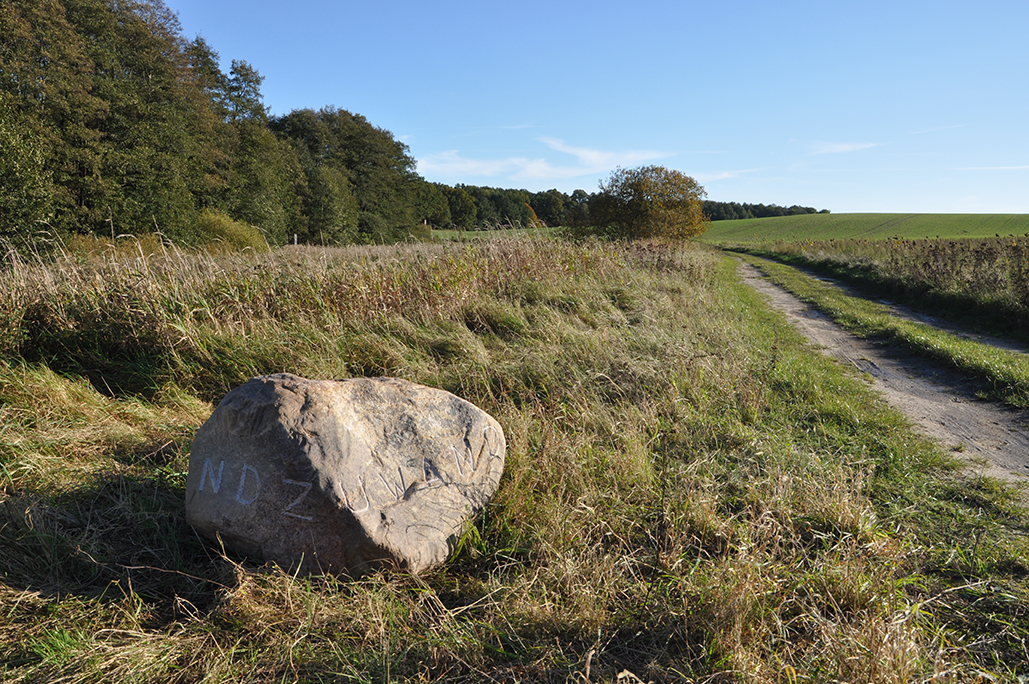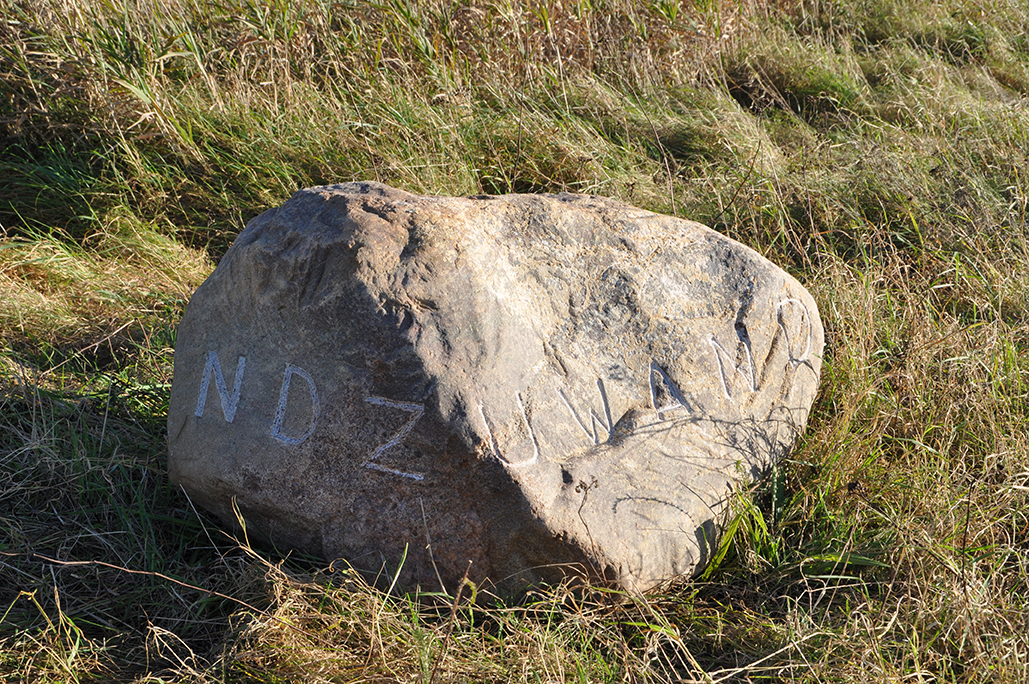

A B U N D Z U W A N D E R N
Glacial erratic
130cm x 80cm x 90cm
2021
The work A B U N D Z U W A N D E R N is made from a glacial erratic found in the northern German state of Mecklenburg-Vorpommern. Glacial erratic are stones and boulders which have been transported by glaciers during the ice age. They are among the first materials that were used to mark places and delineate boundaries. Originating from Scandinavia, glacial erratic found in Northern Europe were transported south through glacial movement. Consisting mostly of hard stone such as granite and quartzite, they are geologically foreign to the local bedrock. Not only because of their size and weight, but also because of their visual difference, erratic boulders were particularly suitable as border markers. Borders and ideas about what is foreign, have changed throughout the course of history.
The work consists of the letters A B U N D Z U W A N D E R N chiseled into the surface around the boulder. It is a play on words in German, on the phrase “ab und zu wandern”- “to go for a walk now and then” - and the words “abwandern”- “to emigrate from” and “zuwandern" - “to immigrate to”.
It can be interpreted as a leaving of one's homeland, or as traveling to new home, as a call for an occasional walk in the landscape or as a change of residence or occupation. It alludes to the shifting of boundaries as well as the geological history and movement of the boulder.
A country’s border is a political barrier which requires permission to enter and reside. Who may enter and who is denied depends on an individual’s identity. Today, such permission is granted in the form of a visa. A specific typography is used to reaffirm and record this acceptance. The modern sans-serif typography used in A B U N D Z U W A N D E R N is the same type used in my residence permit, referencing how the constructs of borders and identity are recorded through written language.
Just as the erratic boulder is contradictorily part of Scandinavia and yet of course part of Germany, indeed older than the state of Germany, this work considers the ambiguous construct of borders and identity. Placed along a field path where locals go jogging and for evening walks, it does not mark a specific place or boundary, but draws attention to the changing space in which one lives and through which one passes.
Glacial erratic
130cm x 80cm x 90cm
2021
The work A B U N D Z U W A N D E R N is made from a glacial erratic found in the northern German state of Mecklenburg-Vorpommern. Glacial erratic are stones and boulders which have been transported by glaciers during the ice age. They are among the first materials that were used to mark places and delineate boundaries. Originating from Scandinavia, glacial erratic found in Northern Europe were transported south through glacial movement. Consisting mostly of hard stone such as granite and quartzite, they are geologically foreign to the local bedrock. Not only because of their size and weight, but also because of their visual difference, erratic boulders were particularly suitable as border markers. Borders and ideas about what is foreign, have changed throughout the course of history.
The work consists of the letters A B U N D Z U W A N D E R N chiseled into the surface around the boulder. It is a play on words in German, on the phrase “ab und zu wandern”- “to go for a walk now and then” - and the words “abwandern”- “to emigrate from” and “zuwandern" - “to immigrate to”.
It can be interpreted as a leaving of one's homeland, or as traveling to new home, as a call for an occasional walk in the landscape or as a change of residence or occupation. It alludes to the shifting of boundaries as well as the geological history and movement of the boulder.
A country’s border is a political barrier which requires permission to enter and reside. Who may enter and who is denied depends on an individual’s identity. Today, such permission is granted in the form of a visa. A specific typography is used to reaffirm and record this acceptance. The modern sans-serif typography used in A B U N D Z U W A N D E R N is the same type used in my residence permit, referencing how the constructs of borders and identity are recorded through written language.
Just as the erratic boulder is contradictorily part of Scandinavia and yet of course part of Germany, indeed older than the state of Germany, this work considers the ambiguous construct of borders and identity. Placed along a field path where locals go jogging and for evening walks, it does not mark a specific place or boundary, but draws attention to the changing space in which one lives and through which one passes.




© Joshua Zielinski - 2025